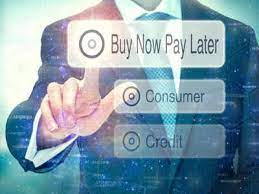Buy Now Pay Later Loans: US Holiday Shopping Season’s Hottest Product
Please note that we are not authorised to provide any investment advice. The content on this page is for information purposes only.
Small businesses are facing some of the biggest challenges this holiday season that is making Christmas not to be merry. These changes include supply chain issues emanating from shipping delays and labor shortages. These have led to product shortages and rising product prices. However, there is one financial product that is saving Christmas for thousands of shoppers this year, “buy now pay later” (BNPL) loans.

The use of BNPL loans has exploded in the recent past, particularly among U.S. shoppers.
According to Dan Schulman, the CEO of the payments service PayPal that the use of BNPL usually increases during the holidays season. While speaking to CNBC, Schulman said, “During Black Friday, our volume on buy now, pay later was up almost 400% year over year. We did some 750,000 transactions alone in one day.” PayPal has recorded more than a million first-time BNPL users and its total usage stands at over 10 million consumers.
Buy Now Pay Later Loans Are Increasing In Popularity: Key Statistics
Data from leading marketing research agencies show that BNPL has become so popular as a financial product and lenders are using the increasing consumer demand during the holidays to cash in on the benefits.
A report by C+R Research, a leading marketing insights agency shows that approximately 60% of U.S. citizens aged 18 years and above have used BNPL to fund their shopping at one point or another. And according to a report by Morning Consult, a data intelligent firm, 80% of those who have used it before plan on using it for their holiday shopping this year.
This is not just a product for the middle-aged U.S. shoppers alone. No. The Younger shoppers live it too. Nearly 60% of Generation Z and Millennials have used the product when paying for their merchants online, a study by StitcherAds reveals. More data from E-commerce firm Adobe’s Digital Economy Index shows a rise in BNPL use. The firm analyses direct online consumer transaction and found that revenue on Cyber Monday from buy now pay later loans rose by 21% year-on-year.
BNPL Explained
The “buy now, pay later” concept is now new. In fact, it is an age-old concept that many shoppers used to fund their purchases.
It borrows its concept from the traditional layaway programs that were used back in the days, but with a twist. Layaway plans were only used for big purchases like when getting a dining room set or a new remote-controlled TV.
Nowadays, shoppers take BNPL for smaller transactions, both online and in store, and users can walk away with their purchases after making their first payment. BNPL loans allow a shopper to split their holiday spending over time. Afterpay, Affirm, PayPal Credit and Klarna are among the most popular platforms that offer BNPL loans and their services can be used when purchasing from merchants of all sizes.
Apart from the increased use among shoppers, BNPL has also increased in popularity among small business who increasingly accept it a means of accepting payments for services rendered. This is because, BNPL is easy to set up for small merchants. If, for example, a consumer wants to buy something, the BNPL service is plugged in to the payment option on the merchant’s site or in-store.
BNPL usually offers the consumer an interest-free period where they are required to make installments payments, similar to those made for personal installment loans, but over a shorter period – usually a few weeks or months.
There re usually no credit checks when signing up for a BNPL plan and consumers shoppers can avoid using their credit cards where they have to clear the balance within the set period.
Pros And Cons Of Using Buy Now Pay Later Loans
No doubt there are some downsides to using BNPL plans. For consumers, failure to pay off the balance within the agreed period results in late fees and interest payments which could be as high as 25% in some instances. In addition, the credit limit offered by BNPL service providers is smaller and the credit score can be affected if the payments are not made on time.
For merchants, most BNPL providers require a fee which ranges from 1.5 to 1.7% of the purchase value (inclusive of data). But this is a bit cheaper when compared to the cost of payment arrangements involving debit and credit-card transactions, which usually range from 1 to 3%. On the other hand, having a BNPL arrangement makes it easier to make sales. Research by Morning Consult has shown that shoppers using BNPL plans spend more on shopping than what an average shopper would spend for their entire Christmas shopping.
“I think there is an impulse element to this, and that these companies do make a lot of money by partnering with retailers. There’s a lot of data that people spend more when they use buy now, pay later, [and] they come back again and again” Joe Buhrmann, senior financial planning consultant at eMoney Advisor.
Bottomline
Is a BNPL plan a good thing? For the disciplined consumer, yes. But considering all the challenges that the average U.S. consumer has to deal with this Christmas season, taking up a BNPL loan could just add to the financial burden which most have with personal loans such as payday loans and Christmas loans. However, if you are disciplined shopper and you have not signed up for one of the BNPL plans, you may be missing an opportunity.




